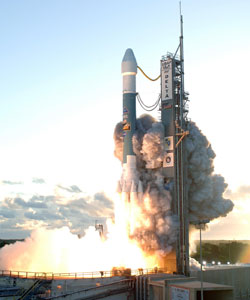Ignition and Lift-Off
One of the fascinating things about rocket science is that it combines several fields into one. For this section, the prevalent field is chemical engineering. Rockets use fuel as a means for propulsion, which in physics terms, is the process of converting chemical potential energy into kinetic energy. The fuel that rockets use can come in many forms, there are gaseous forms, liquid forms, and solid forms, all of which undergo some sort of chemical reaction which directly transfers to thrust.
 For most rockets, the fuel is a
stable compound, and requires an external power to ignite
it. This initial ignite can range from a spark to an
For most rockets, the fuel is a
stable compound, and requires an external power to ignite
it. This initial ignite can range from a spark to an open flame, all of which function to begin the chemical reaction of transferring the fuel into thrust. Thrust is the force that the engine exerts on the rocket. Thrust is what causes the rocket to actually move.
The physics behind Lift-Off is extremely complex. Inertia takes on a huge role in the actual change in position. According to Newton's Third Law of Motion, For every action, there is an equal and opposite reaction. This means that, for the force that the engine is spewing towards the ground, there is an opposite reaction that the ground is exerting on the engine, therefore the rocket. This force is what causes the rocket to move, but then Newton's First Law of Motion must be accounted for. Newton's First Law of Motion, commonly referred to as the Law of Inertia states that an object at rest will remain at rest unless acted on by an unbalanced force. An object in motion continues in motion with the same speed and in the same direction unless acted upon by an unbalanced force. In rocketry terms, for the rocket to begin moving, it must overcome its own inertia. Inertia is function of mass, therefore, the rocket's mass has to be accounted for.